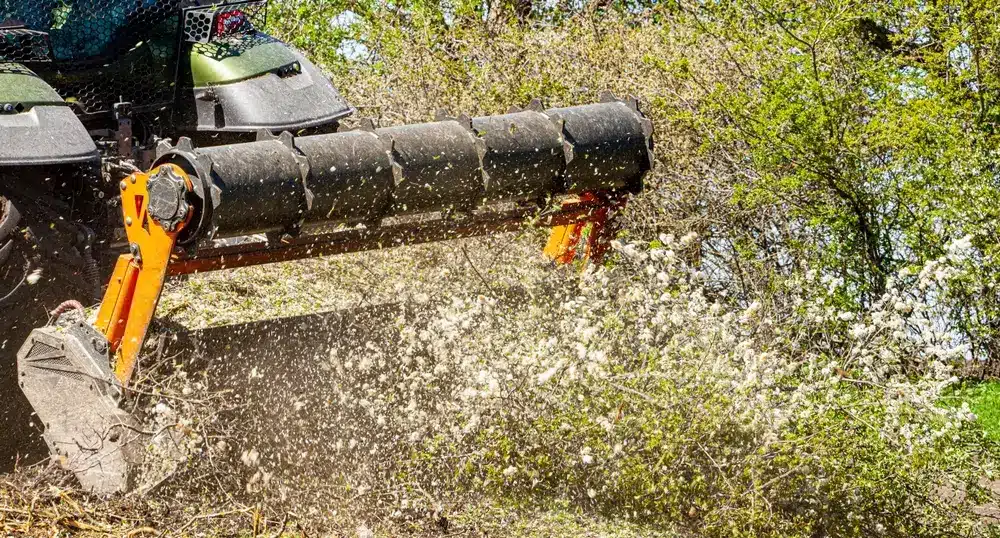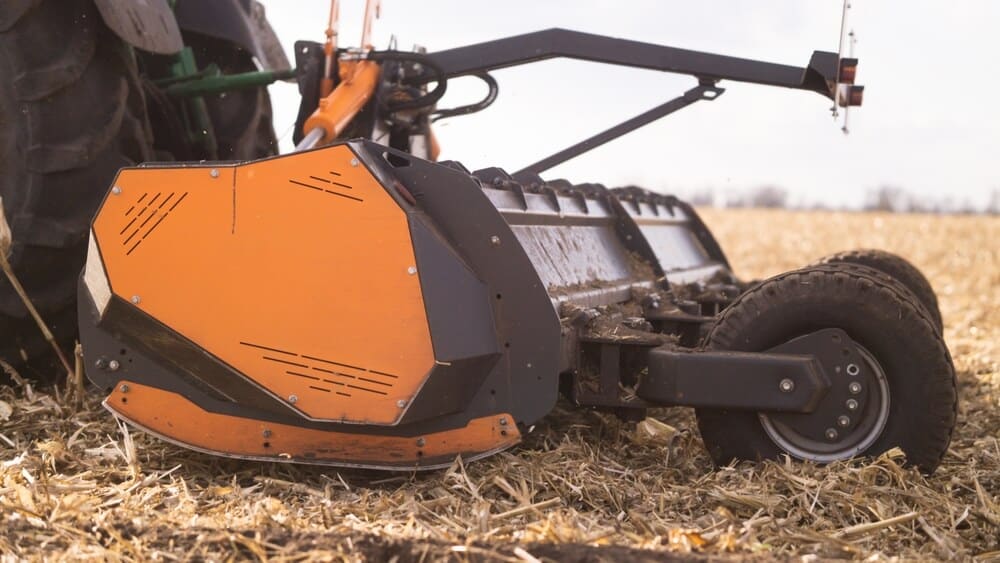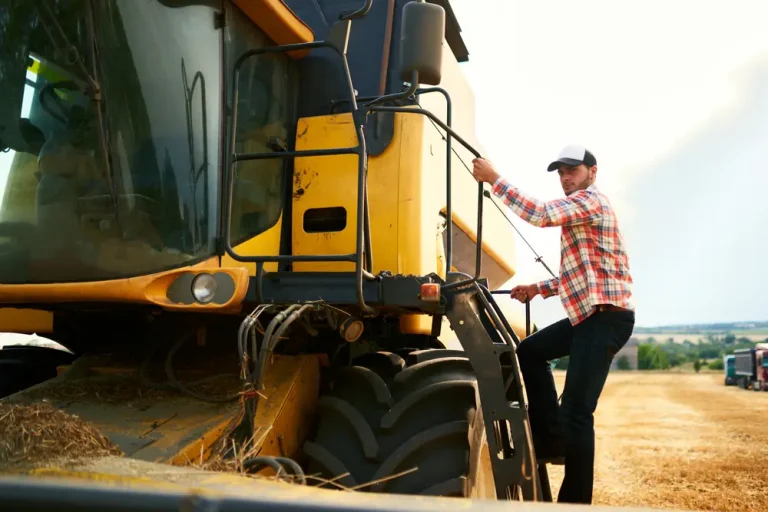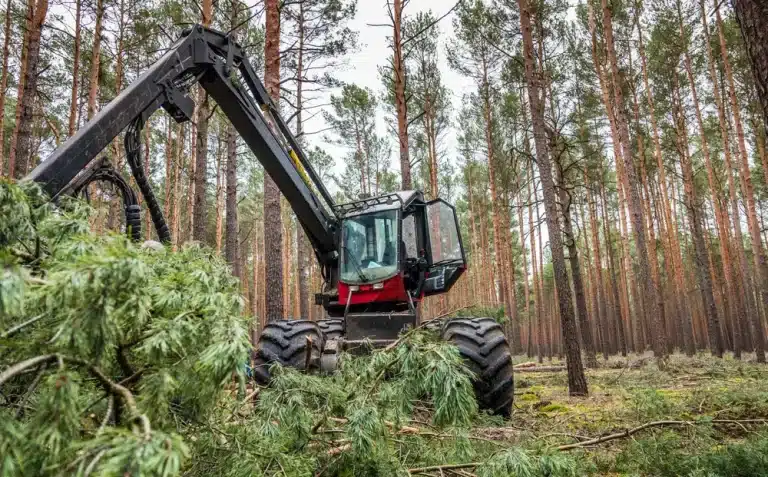Mulchers are powerful, adaptable machines designed to process a wide range of vegetation, from small grasses to massive tree trunks.
Their effectiveness lies in their versatility, they’re capable of clearing dense forests, managing light brush, and maintaining pastures, all while preserving soil integrity.
Knowing which vegetation types your mulcher can tackle helps you select the right tool for your job, whether you’re clearing land for agriculture, performing post-disaster recovery, or managing invasive species.
To explore more about our work in land restoration, visit our about page or browse our services.
Woody vegetation: trees, shrubs, and brush
Woody vegetation is often the most demanding to clear. Thick trunks, gnarled branches, and heavy stumps require machines that can deliver torque and resilience without faltering.
Small trees and underbrush
Forestry mulchers are ideal for managing saplings and thick brush that quickly overtake neglected land. This is particularly useful in fire prevention zones and in preparation for reforestation projects.
Skid steer mulchers offer the maneuverability needed to operate in tighter areas, while spider excavator mulchers can scale steep or uneven terrain with ease.
If you’re unsure which system suits your site, our guide on Skid steer mulchers vs spider excavator mulchers provides a detailed comparison.
Mature trees and stumps
For larger tree removal, heavy-duty drum mulchers equipped with reinforced teeth can grind down trunks and break stumps into mulch. This is critical during disaster recovery when time is short and access is limited.
Proper mulching also prevents regrowth and prepares the land for new construction or planting.
The best mulchers for woody vegetation:
- Skid steer forestry mulchers for saplings and thick brush
- Drum mulchers with reinforced teeth for stumps and trunks
- Spider excavator mulchers for unstable or sloped terrain
When dealing with this kind of debris, regular machine upkeep is critical to maintain cutting efficiency and avoid field failures. Visit our page on how to maintain your forestry mulcher for long-term performance for essential guidance.
Grasses and herbaceous plants

Light vegetation like grasses and herbs may seem easy to clear, but it requires precision to avoid soil disruption or unintended damage.
Tall grasses and field maintenance
Flail mulchers excel at controlling overgrown fields, wild grasses, and light weeds.
Their swinging blades create a fine cut without tearing up the ground, making them suitable for pasture management, urban edges, and roadside cleanup.
This approach is common in preventive work, especially in zones prone to fire outbreaks. For additional context, see how mulchers help reduce wildfire risks in dry zones.
Herbaceous vegetation in sensitive areas
In these fragile zones, using flail mulchers or spider machines with extended reach reduces physical disturbance, which is critical for maintaining natural drainage patterns and preventing erosion. This method aligns with sustainable land management strategies that prioritize terrain preservation.
A flail mulcher will be the best choice in these situations:
- Pasture and field maintenance
- Vegetation control near wetlands or rivers
- Clearing soft-stemmed growth without disturbing topsoil
These are also key to sustainable land management, where the goal is long-term ecological balance rather than total clearance.
Invasive species and brush control
Certain types of vegetation grow aggressively and choke out native species. Mulchers offer a fast, efficient solution to manage these threats before they spread out of control.
Fast-growing invasive plants
Species like kudzu, bamboo, or blackberry thickets can overtake large areas in months. Using a mulcher to grind them down repeatedly weakens their root systems and slows regrowth. This is especially useful in disaster-affected areas where invasive species quickly move into disturbed soil.
Some of the most common invasive vegetation you’ll find on your way:
- Kudzu and bamboo
- Blackberry and thorny thickets
- Fast-spreading vines and shrubs
For recovery tactics, read the best mulching tools for post-disaster cleanups.
Brush suppression in managed landscapes
Controlled brush clearing improves visibility, reduces fire fuel, and creates buffer zones in agricultural and urban interfaces. Mulching reduces manual labor while maintaining low environmental impact, especially when done regularly.
How vegetation type affects mulcher selection (infobox)
Choosing the right mulcher depends on factors like plant moisture, wood hardness, terrain slope, and operator skill. As a general guide:
- Flail mulchers are ideal for light brush, grasses, and urban environments
- Skid steer forestry mulchers handle small trees and dense brush with ease
- Spider excavator mulchers tackle steep terrain and heavy timber with maximum control
Vegetation in difficult terrain
Vegetation rarely grows in flat, obstacle-free zones. Rocks, slopes, wetlands, and unstable soil all demand tailored tools and experienced operators.
Steep or rocky land
Spider excavators equipped with forestry mulchers are designed to handle vegetation in mountainous, sloped, or uneven areas. Their stability and long reach make them invaluable for tasks where standard machines would risk tipping or damage. Proper operation on this kind of ground also requires heightened awareness. See our safety tips when operating a mulcher in rough terrain to avoid accidents and protect your machine.
Wetlands and soft soil areas
In wetlands or near waterways, low-impact mulchers prevent rutting or compaction that would otherwise damage ecosystems.
Vegetation such as reeds, cattails, or soft-stem plants can be cut back with minimal disturbance when using flail attachments or specially designed lightweight machines.
Understanding how your mulcher responds in these zones helps reduce repair costs and environmental harm.
Learn more by exploring mulcher attachments for spider excavator.
Plan your vegetation clearing project

Matching mulcher capabilities with vegetation type leads to faster, safer, and more cost-effective outcomes.
Choosing based on vegetation density
Thicker vegetation requires more power and larger cutting surfaces.
Forestry drum mulchers are best suited for dense wood and stumps, while lighter flail mulchers serve well in grassy or residential environments.
If you’re still weighing your options, our article Renting vs buying a mulcher: what’s best for your project? offers a breakdown of strategic choices.
Setting up for efficiency
No matter the vegetation type, success depends on preparation. Always inspect your worksite, define your boundaries, and inspect your equipment before starting.
Regular upkeep, like blade sharpening and cleaning, can prevent downtime and protect hydraulic systems.
For optimal performance, visit how to optimize mulcher performance on skid steer machines.
3 easy steps for a successful mulching job:
- Match tool type to vegetation density
- Prepare and inspect the site before work
- Perform regular maintenance to ensure machine readiness
Ready to clear your land with confidence?
Understanding the types of vegetation your mulcher can handle is the first step toward smarter land management. Whether you’re reclaiming overgrown fields, performing emergency land restoration, or clearing trails, choosing the right equipment makes all the difference.
“A well-chosen mulcher doesn’t just remove vegetation. It transforms land into something usable again, with speed, precision, and respect for the terrain.”
—Rachel Mendez, ecological recovery consultant
If you need assistance to choose the right mulcher to fit your needs, get in touch or request a free quote. Our team is here to help you select the right equipment and strategy for any type of vegetation or terrain. You can also learn more about us or explore the full range of services we offer.
Frequently asked questions
Can a mulcher handle thick tree trunks?
Yes, high-powered drum mulchers can break down large trees and stumps, but you need the right attachment and enough hydraulic flow to support the workload. For extremely dense vegetation, spider excavators with reinforced mulcher heads are recommended.
What is the smallest vegetation a mulcher can clear?
Mulchers can efficiently process light grasses and small weeds. Flail mulchers are particularly effective in clearing soft vegetation without disturbing the soil structure, especially in environmentally sensitive areas.
Are mulchers effective in wetlands or near water?
Yes, provided you use low-impact equipment. Lightweight skid steer mulchers or spider excavators with wide tracks reduce ground pressure and avoid damaging soft terrain, making them suitable for marshes and streambanks.
How do I know if I need a drum or flail mulcher?
Choose based on the density and type of vegetation. Drum mulchers are better for woody material and large-scale clearing, while flail mulchers are ideal for maintenance, grassy zones, and urban edges.
Can one mulcher handle multiple vegetation types?
Yes, many mulchers are built for mixed vegetation, especially if fitted with interchangeable teeth or variable-speed heads. However, performance depends on matching power, terrain, and vegetation density. Need help choosing? Request a free quote.



